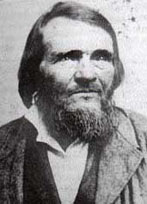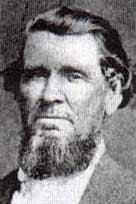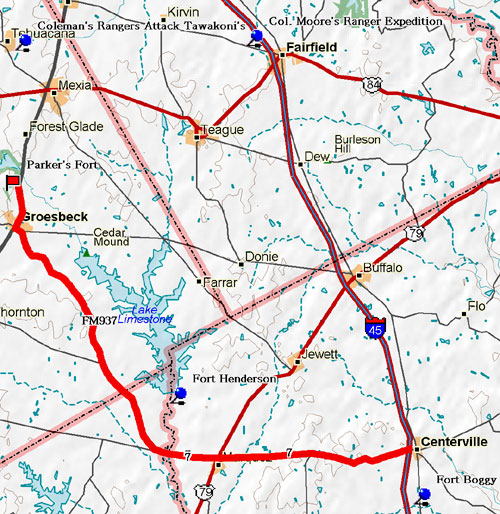|
||||||||
 |
 |
Daniel Parker Sr. |
Abram Anglin,
|
Marker Title: Fort Parker
Address: Of FM 1245, in Fort Parker Historical Park
City: Groesbeck
County: Limestone
Year Marker Erected: 1965
Marker Location: Fort Parker Historical Park, off SH 1245
on park rd. 35, N. of Groesbeck.
Marker Text: Built 1834 for protection from Indians. Named
for leaders who bought first Predestinarian Baptist church body to Texas:
Elder Daniel Parker; his father, Elder John; brothers Jas. W., Benjamin,
Silas, John. Also here were Kellogg, Frost, Nixon, Duty and Plummer
families on May 18, 1836, raiding Comanches killed Benjamin, John and
Silas Parker, Samuel and Robert Frost and others; captured Elizabeth
Kellogg, Rachel Plummer and son James, and Silas's children, John and
Cynthia Ann in captivity, Cynthia Ann married Chief Peta Nacona; her
son, Quanah, was last Comanche Chief. With her baby, Prairie Flower,
in 1860 she was captured by Texas Rangers. She, the baby and Quanah
are buried at Fort Sill.
Fort Parker Memorial Park Historical Marker
Marker Title: Fort Parker Memorial Park
Address: Off FM 1245, in Fort Parker Historical Park.
City: Groesbeck
County: Limestone
Year Marker Erected: 1964
Marker Location: Off FM 1245, on Park Rd. 35, Fort Parker
Historical Park, N. of Groesbeck
Marker Text:--
Old Fort Parker State Historic Site Historical Marker
Museum Name: Old Fort Parker State Historic Site
Mailing Address: Rt. 3 Box 746
Street Address: State Park Rd. 35
City: Groesbeck
Zip Code: 76642
Area Code: 254
Phone: 729-5253
County: Limestone
More on Parker's Fort
Fort Henderson
This Texas Ranger fort was built by Major William H. Smith's battalion early in 1837 and commanded by Captain Lee C. Smith as part of the defensive line established by the Republic of Texas against marauding Plains Indians. The fort was named for General James Pinckney Henderson. It was on the upper Navasota River near the present boundaries of Robertson and Leon counties. At that time, this area was deep in Indian country. The fort was difficult to supply and of questionable defensive use. For those reasons the fort was abandoned soon after its construction, probably in the fall of 1837. There are no visible ruins.
Fort Boggy Historical Marker
Marker Title: Fort Boggy
City: Centerville
County: Leon
Year Marker Erected: 1985
Marker Location: from Centerville, take I-45 south about
5 mi. to rest area on southbound side of highway.
Marker Text: Pioneers who settled in this area bout 1840
included members of the Middleton, Byrns, Staley, Erwin, Jones, Capp,
Bloodworth, Philpott, Easton, Howell, and Hinton families. Nearby Kichai
and Kickapoo Indian camps afforded these early settlers little sense
of security. On February 5, 1840, Christopher C. Staley was ambushed
and killed by a group of Indians while out hunting near his home. This
incident led to the building of Fort Boggy for the protection and safety
of the settlers. Named for its proximity to Boggy Creek, the fort consisted
of two blockhouses with eleven dwellings inside an area of about 5000
square feet. A military company, authorized by Texas President Mirabeau
B. Lamar, was formed under the leadership of Capt. Thomas Greer to protect
the fort. According to one account, 77 people moved into the fort upon
its completion. Illness proved to be a major problem for them. In 1841,
while leading a scouting party beyond the fort, Captain Greer was killed
in an Indian attack. Soon after, the threat of raids lessened, and the
need for Fort Boggy no longer was vital. For many years, however, a
community church and school retained the name "Boggy." As
an early aid in the settlement of this area, Fort Boggy remains significant
to the history of Leon County.
Fort Boggy Historical Marker
Marker Title: Site of Fort Boggy
City: Centerville
County: Leon
Year Marker Erected: 1936
Marker Location: from Centerville, take SH 75 about 4.5
mi. south, marker is to the west, off road, just north of Boggy Creek
bridge, in area being developed for future state park.
Marker Text: Here a blockhouse was constructed in 1840
as headquarters for the Boggy and Trinity Rangers commanded by Captain
Thomas N.B. Greer. A community retained the name Fort Boggy for a number
of years.
*Coleman's Rangers Attack Tawakoni's
In July of 1835, Coleman's Rangers attacked a force of over one hundred Tawakoni's in Limestone County. Coleman later wrote, "We had a severe battle. One fourth of my men was killed and wounded. We took their encampment by charge and the battle ended." They arrived back at Parker's Fort on July 11th.
*Colonel Moore's Ranger Expedition
They departed Parker's Fort in early August and moved northeast toward the Tawakoni Village. Twenty miles over the prairie they came to Post Oak Creek, a tributary to the Trinity River.
The officers were strict about keeping the men in line. From Captain George Barnett's ranger company, Privates Samuel McFall and George Erath darted far ahead of the rest of the volunteers on their horses. It was not, however, by their own choice, as Erath recalled.
"I was riding a young horse which had been caught a colt from the mustangs, that was fiery. When the order came to charge, it darted forward ahead of all the rest, and I found myself alone in the advance. Next came McFall, who was also on a wild horse, too eager for the fray. The officers shouted to us to come back into line, but our efforts to obey were in vain. Our steeds had determined to give us a reputation for bravery which we did not deserve." Erath's daughter recalled that this incident even helped earn her father the nickname "The Flying Dutchman."
The Indians scattered but the Rangers continued the pursuit. Though several Indians were encountered, the only fatality was that Ranger Moses Smith Hornsby was accidentally killed by Ranger William Magill.
* items are taken directly from the book, Savage Frontier, by Stephen L. Moore.
Home | Table of Contents | Forts | Road Trip Maps | Blood Trail Maps | Links | PX and Library | Contact Us | Mail Bag | Search | Intro | Upcoming Events | Reader's Road Trips Fort Tours Systems - Founded by Rick Steed |
